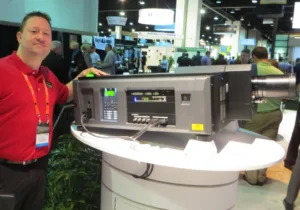Projection Displays – At CEDIA Expo 2014 in Denver, CO, USA, Digital Projection exhibited two new 4K projectors. The new Insight 4K projector models are offered in laser and LED illuminated versions offering two different projection solutions for what the firm calls the “elite home entertainment” market. The laser illuminated version of the Insight 4K projector was demonstrated in the Digital Projection booth at CEDIA Expo (photo below).
Photo: Phil Wright
The two 4K projectors with solid state light sources comprise a laser-illuminated model offering 12,000 lumen output and an LED-illuminated model rated at 2,000 lumen that provides a color gamut corresponding nearly to the REC 2020 color space as shown below.

Source: Digital Projection
Both Insight 4K projectors are based on 4K (4096 x 2160) DLP technology. Digital Projection emphasizes that the solid state light sources of both projectors “remove the regular lamp replacement cycles from the ownership experience”. The Insight 4K laser is rated at 20,000+ hour illuminator lifetime. The Insight 4K LED projector illuminator is described by the firm as offering “Lifetime Illumination” and is rated at 50,000+ hour illuminator lifetime.
Based on my conversation with Jim Groover and Michael Bridwell in the Digital Projection booth during CEDIA Expo, the Insight 4K laser projector utilizes a hybrid blue laser plus yellow phosphor wheel illumination system. Red and green primaries are generated from the yellow phosphor output through dichroic filter separation in the subsequent optical train. This laser hybrid illuminator provides the projector’s high lumen output but the spectral output width of the red and green primaries apparently limits the color gamut as compared to the LED illuminated Insight 4K projector.
The output and color space of the LED illuminated Insight 4K projector was of great interest to me. Digital Projection had set up a nice demo theater at the rear of their CEDIA Expo booth to demo the Insight 4K LED projector. As compared to the Insight 4K laser projector on the lighted show floor out front, the demo theater provided an opportunity to carefully view the display capabilities of the lower output LED illuminated version. The outstanding color gamut of the LED projector was apparent during the demo with no visible color banding and the perception of good brightness from the projection screen in the darkened demo theater.
Digital Projection emphasizes that the Insight 4K LED projector offers a wide color space and good black levels enabled by LED illumination. The firm during its demo of the LED illuminated projector and in their product literature is particularly careful in describing and representing the lumen output of the Insight 4K LED projector. In particular, the firm describes the benefits of their LED illuminator approach citing the perceptual benefits owing to the Helmholtz-Kohlrausch (H-K) effect.
Digital Projection states: “Though often measured as less bright than many lamp-based projectors, LED projection systems are perceived by the viewer as being much brighter than their measured luminance specifications, thanks in part to the Helmholtz-Kohlrausch effect (H-K effect). The International Electrotechnical Commission defines the Helmholtz-Kohlrausch effect as, ‘A change in brightness of perceived color produced by increasing the purity of a color stimulus while keeping its luminance constant within the range of photopic vision.’ In layman’s terms, the H-K effect describes a situation whereby if two color stimuli sources with the same luminance are compared, the perceived brightness induced by the color stimuli of higher purity will be higher than that of lower purity. Why is this important? LED illuminated projectors produce extraordinarily high color purity and saturation. Thus, they appear much brighter, sometimes up to 30% brighter, than a lamp-based display with similar measured lumen specifications”.
In my discussion with Digital Projection personnel, I was told that the LED projector utilizes 3-chip RGB LEDs from Luminus. A check at Luminus shows that the firm offers large area LEDs with lifetimes in excess of 60,000 hours and peak wavelengths of red 623 nm, green 525 nm, and blue 460 nm.
Technical specifications for both Insight 4K projectors include: 3D display capability; dual HDMI and DVI inputs; a full range of 4K lenses offering throw ratios from 1.13:1 to 4.98:1 with extensive vertical and horizontal lens shift. A preliminary spec sheet for the Insight Laser 4K can be found here (PDF). The Insight 4K laser projector priced at $120,000 begins to ship in September 2014, while the Insight 4K LED priced at $150,000 will be available in Q1, 2015. – Phil Wright

